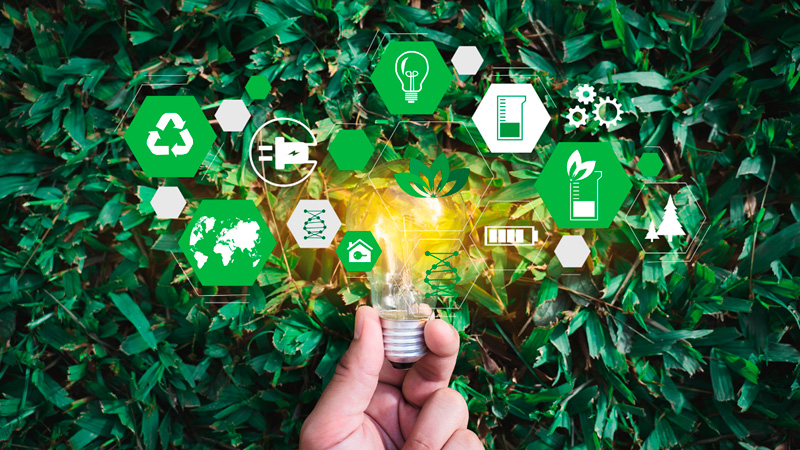In a recent blog, I shared our first year’s experiences of producing and using solar power. When it comes to sustainability, building a solar photovoltaic system on the roof of our HQ in Lahti, Finland was one of last year’s important undertakings. In this blog, the focus is on our main sustainability goals for 2020-2021.
The safety of our people
Safe working and safe visiting – these are two of our safety cornerstones. Zero accidents is our aim, and the shared mindset in our company is that everyone can make a change. Having a safety initiative program has led to our own people actively recognizing and reporting potential risks before they have turned into actual accidents or near-misses.
Involving our staff is also vital in one of this year’s main projects, which is the transition from OHSAS 18001 to ISO 45001. We are on the road to become ISO 45001 certified by the end of 2020. While both standards target the improvement of occupational safety and health, ISO 45001 takes a more proactive and preventive approach, increasing employee participation as well.
This means for instance more comprehensive risk assessments, internal audits, and employee training. The approach in the new certification works quite well with our mindset of safety being everyone’s responsibility.
If you are keen on reading a bit more about safety at Stalatube, my colleague and our Safety Manager Ari Sarajärvi has not so long ago shared his views on the topic here.
Our environmental goals in 2020 and 2021
In addition to working towards zero accidents, we target some main environmental goals. Last year, we mostly concentrated on implementing ISO14001 environmental management system requirements and significant processes to Poland factory. We also estimated our GWP (Global Warming Potential), which you can actually read about in my next blog.
Within the next year – by the summer of 2021 – we aim to decrease solid waste (waste-to-energy) by 10%, landfill waste by 25% and wood waste by 40 %.
In 2020-2021, we work on minimizing waste. To be more specific, the key waste types we strongly focus on at the moment are solid waste (waste-to-energy), landfill waste and wood waste. Within the next year – by the summer of 2021 – we aim to decrease solid waste (waste-to-energy) by 10 %, landfill waste by 25 % and wood waste by 40 %.
Our means for reaching these goals include thoroughly analyzing the contents of these waste types, enhancing co-operation with waste management partners, increasing monitoring, and further developing instructions and the know-how of our personnel. We also actively look for ways to decrease or alter the use of our products’ packaging materials.
Waste is not the only thing recycled at Stalatube. Once our products come to the end of their service life – be that in offshore platforms, bus bodies or buildings (or any of the countless other applications, for that matter) – they are still fully recyclable. This means we in turn can purchase and use coils made of recycled stainless steels. Recycling does not change the mechanical properties, product quality or safety of stainless steel and structures made of it.
In recent years, our goal has been to use 2/3 recycled material. As we have managed to continuously up its share, a new goal of 70% – along with improved procurement criteria – is what we are now working on. Given that we produce 28 000 tonnes of stainless steel hollow sections and profiles annually, it is no small matter. In future blogs, I might dig deeper into the sustainable sourcing of raw materials – it is an interesting topic on its own!
ISO 14001 certified manufacturing in Poland
In 2019, our company started also operating a new production facility in Stryków, Poland, and in this second factory, we produce further processed and special sized stainless steel structures. Achieving ISO 14001 environmental certification was the first main goal for the new Polish factory, and one that we reached with excellent results in the summer of 2020. The earlier mentioned employee participation was an important success factor in this certification process, as well.
Improving sustainability is an ongoing process, it never ends – and that is what draws me in personally.
In 2020-2021, we continue to build the environmental know-how and sustainable operations in the Stryków factory through regular training and follow-up offered for personnel. We also focus on further developing the factory’s waste analysis, reporting and waste management plans.
Improving sustainability is an ongoing process, it never ends – and that is what draws me in personally. It is rewarding to see how individual efforts accumulate and create a strive for mutual goals. In the end, no company works in isolation, though: the big picture is the course of stainless steel from the mill to us as a manufacturer, to our customers and eventually to what we see around us daily: vehicles, buildings, bridges, industrial sites. Eventually, it makes its way back to the mill again, and the circle continues.
Our sustainability goals are in place to improve that very journey, to literally build a better future together.
